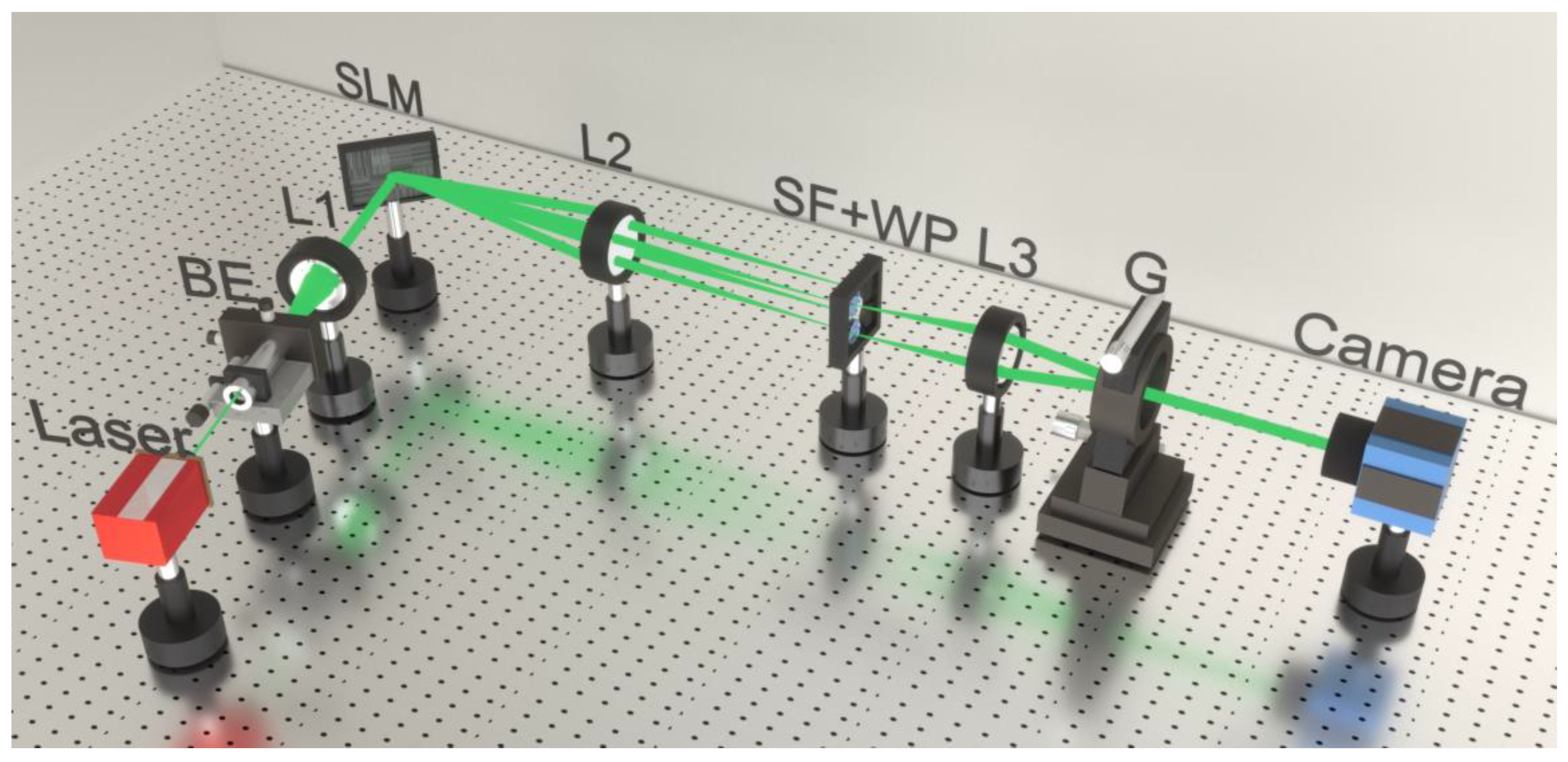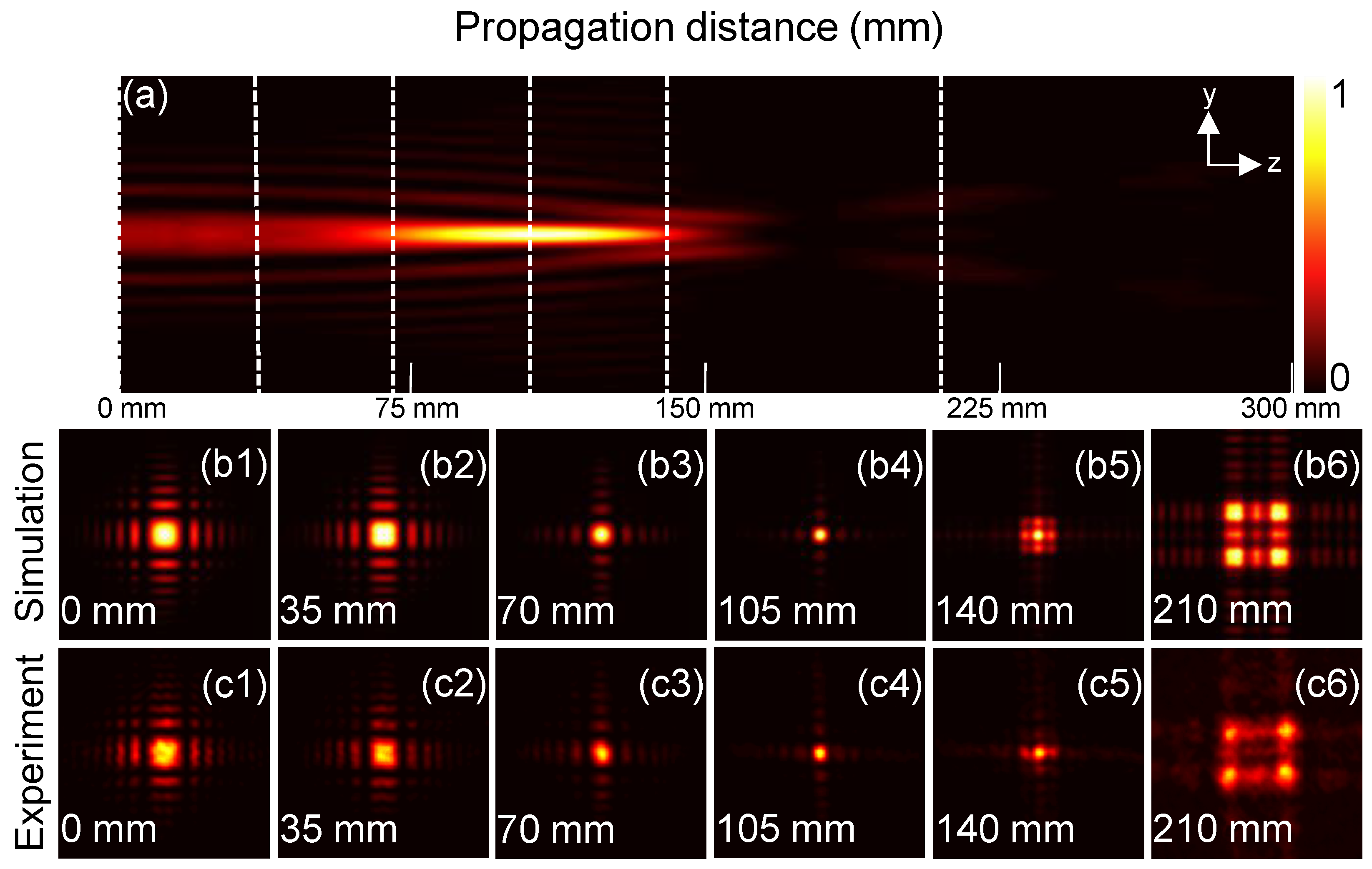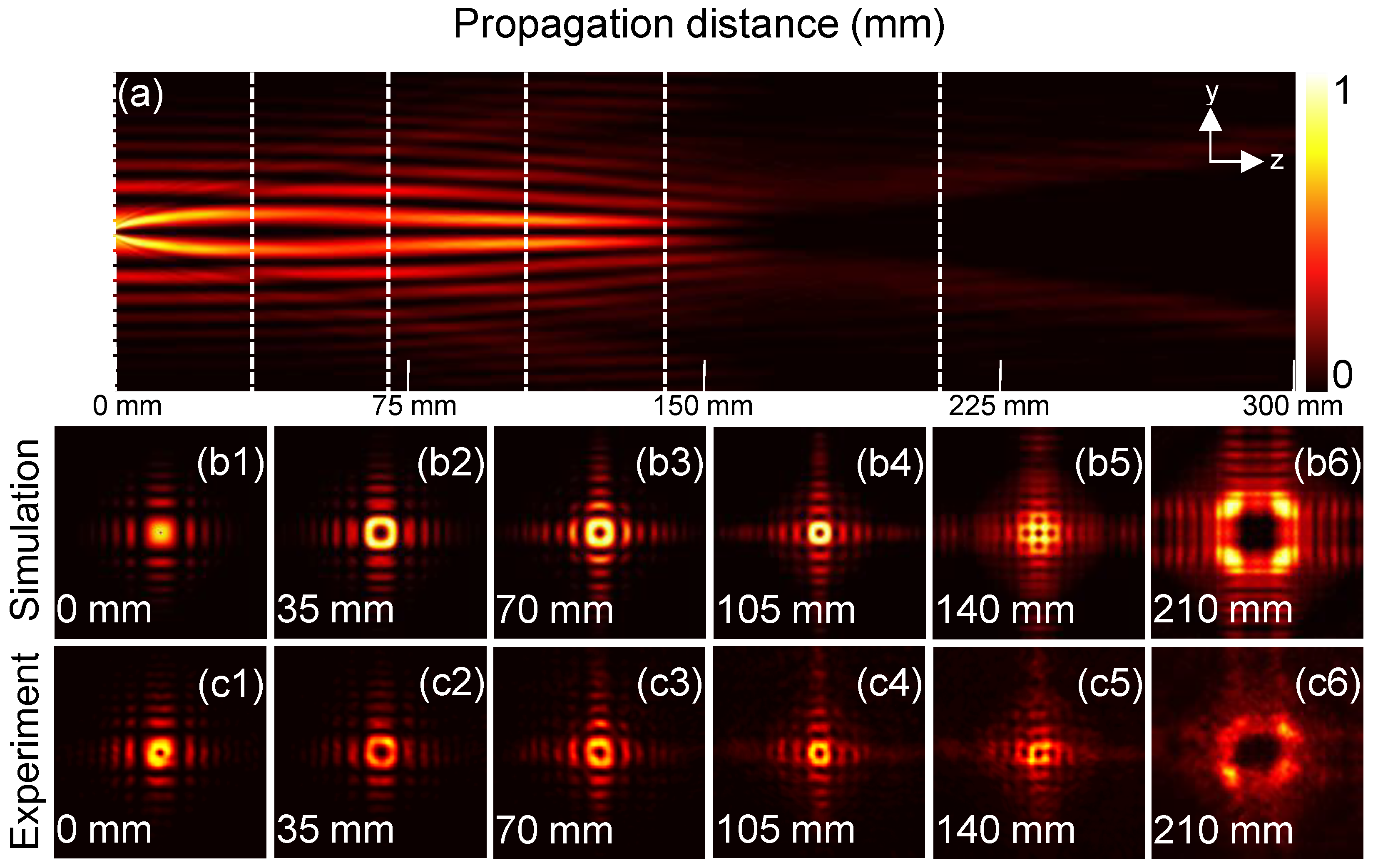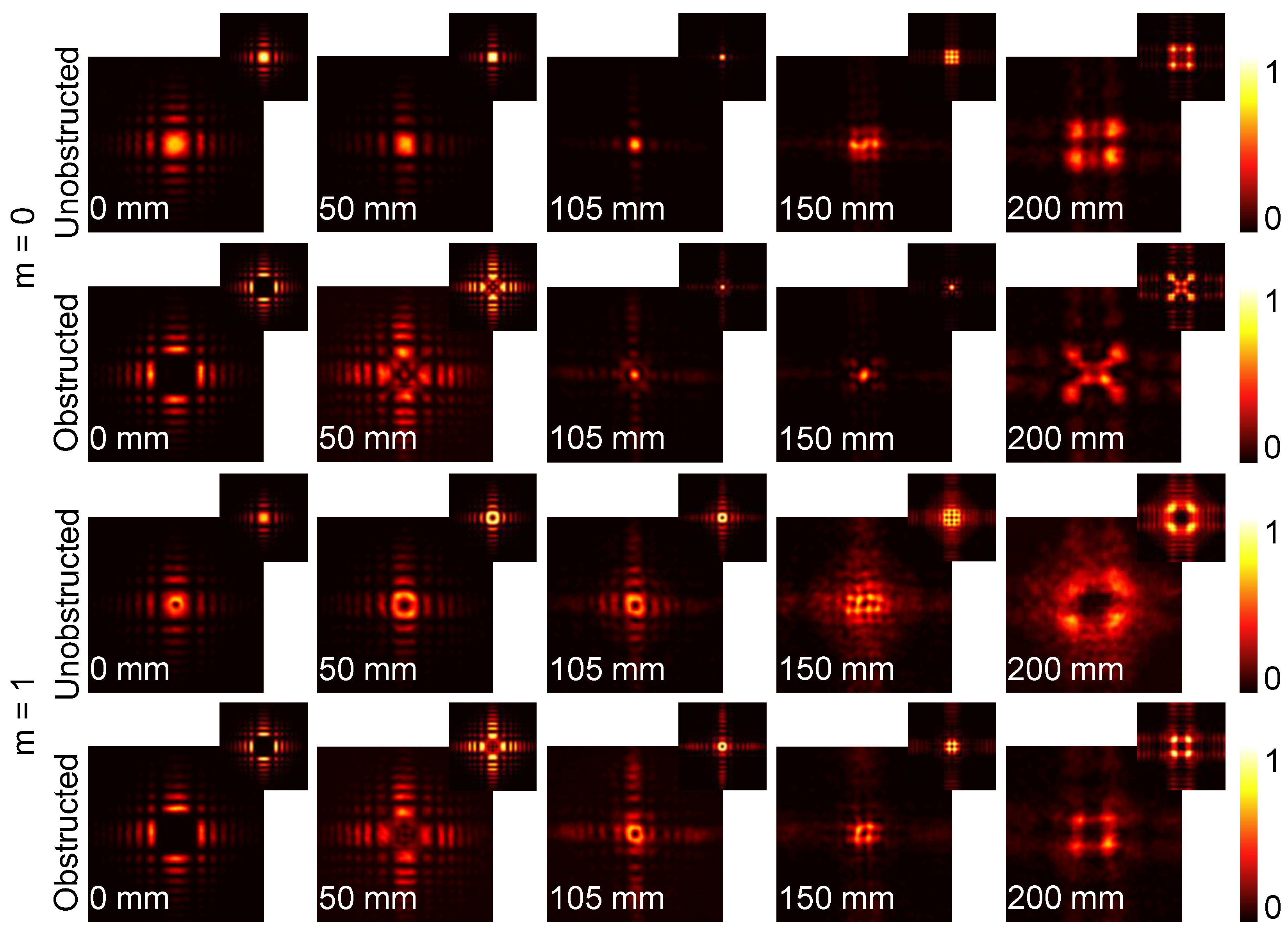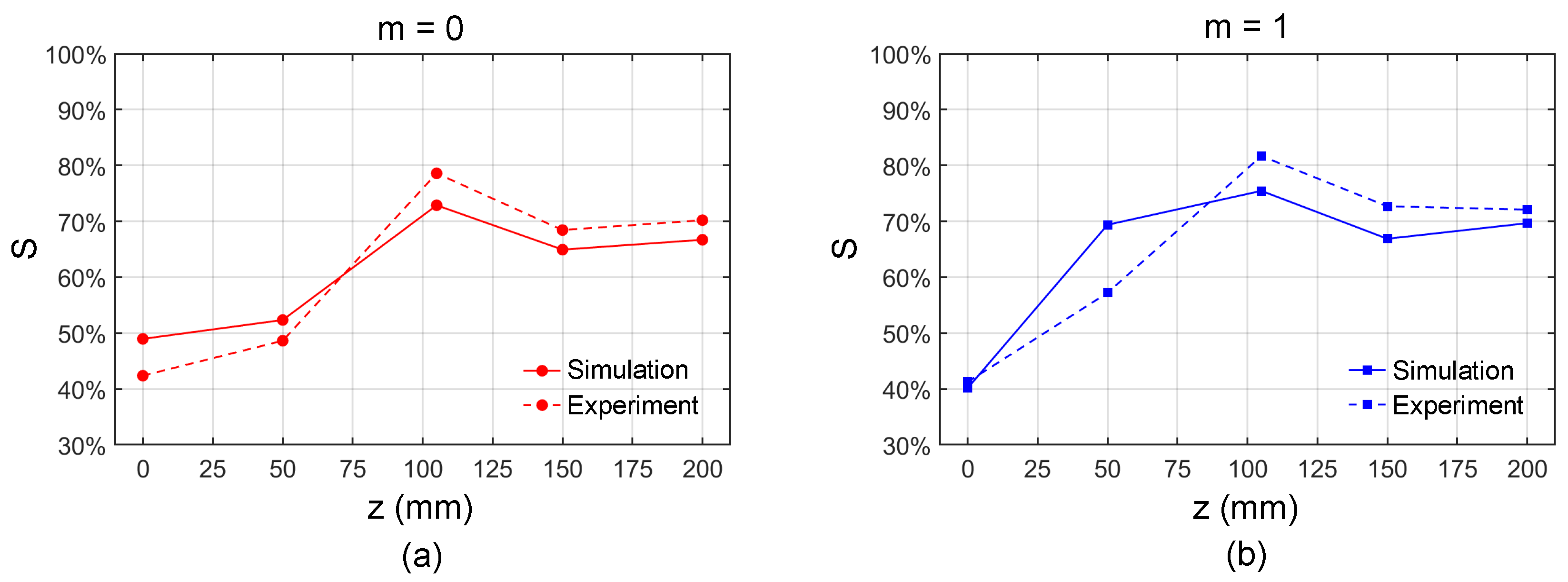2. Theoretical Design and Experimental Generation of the QGAB
We design the QGAB with fourfold symmetry by superimposing the Gaussian and Airy functions, and the amplitude of the QGAB is expressed as
where
denotes the beam waist radius controlled by Gaussian function. (
p,
q) are the indexes of the Airy beams.
denotes the Airy function,
is a transverse scale, and
represents the decay parameter. In constructing the QGAB, four Airy beams are distributed across the four quadrants. In Equation (
1),
p and
q control the positions of the four Airy beams. The main lobes of these four Airy beams overlap at the center while remaining independent elsewhere. At this central overlap region, the phase remains unchanged before and after superposition, whereas the amplitude becomes 2.41 times (not 4 times) that of a single Airy beam. This is because we select the superposition scheme with optimal symmetry. In this way, although the superposition is constructively coherent, the peak positions of the four Airy beams do not perfectly coincide. The quadruple Airy superposition endows the QGAB with fourfold symmetry, enabling complete wavefront coverage and relatively uniform energy distribution, thereby improving both propagation characteristics and energy utilization efficiency. Building upon this quadruple Airy configuration, we further introduced a Gaussian function. This Gaussian envelope imposed on the quadruple Airy structure serves as an overall amplitude and energy attenuator, providing global energy regulation. During preliminary research, we experimentally compared configurations with and without the Gaussian modulation, finding that the Gaussian enhancement improves beam performance, particularly in terms of self-focusing and self-healing properties. To further expand the manipulation degree of the beam, we add the polarization degree to the beam, and the electric field of the QGAB is
where
m is the topological charge and
controls the orientation of the polarization.
and
are the unit vectors in the
x- and
y-directions. In order to simplify the calculation and discussion, we set the initial parameters of the QGAB as
,
, and
in the following discussion.
The experimental setup for generating the QGAB is shown in
Figure 1, which is a common path interferometric configuration with SLM and 4f system composed of a pair of confocal lenses [
25,
26,
27]. The input linearly polarized light emitted from a laser (
= 532 nm) is expanded by a beam expander (BE). The parallel light formed by the lens L1 is incident on the SLM (Pluto-Vis, Holoeye System Inc., Berlin, Germany). The SLM is located in the input plane of the 4f system which is composed of a pair of lenses L2 and L3. The designed two-dimensional binary blazed holographic grating (spatial frequency:
; phase modulation depth: 0.5) is loaded on the SLM. The
st orders (in
x- and
y-directions) selected by a spatial filter (SF) are converted into a pair of orthogonally polarized base vectors by two wave plates (WPs) located at the Fourier plane of the 4f system. The fast axes of the two wave plates form angles of
degrees with the direction of the incident linearly polarized light. The two orders are recombined to form the QGAB by the Ronchi phase grating (G, the period:
; phase modulation depth: 0.5) placed in the output plane of the 4f system. In this way, the QGAB is generated in experiment. To analyze the polarization state, the setup composed of a quarter-wave plate and a polarizer can be used to measure the Stokes parameters of the generated QGAB.
Figure 2 presents the intensity patterns and normalized Stokes parameters of the QGABs when
, 1, and 2, respectively. The intensity patterns and polarization states of the QGABs are shown in the first column of
Figure 2, and the second to fourth columns display the experimentally measured Stokes parameters
,
, and
. The first row shows the QGAB with
x-polarization when
. From the total intensity pattern, it can be seen that the main spot is with maximum intensity, and the other secondary spots distribute with fourfold mirror symmetry. The
x-polarization of the QGAB can be proved by the Stokes parameters, as the Stokes parameter
is positive, while
and
are almost zero. The second row shows the QGAB when
, and the QGAB is with radial polarizations on the wave front. The total intensity pattern is similar with the first row when
, and the only difference is that there occurs a central V-point singularity when
. As the QGAB is with variant linear polarizations, the Stokes parameter
is almost zero, and
and
are azimuthally variant. When
, the QGAB is also with azimuthally variant polarizations, and the linear polarizations rotate with two cycles along the azimuthal direction. The Stokes parameters when
are similar to those when
, which can prove the azimuthally variant polarization distributions of the QGABs. It is necessary to provide a theoretical analysis of the polarization distribution and the formation mechanism of the V-point singularity based on Equation (
2). In Equation (
2),
is a common expression of the polarization of the cylindrical vector beam [
28,
29].
is the polarization azimuth, where
m dictates the spatial period of the polarization rotation. When
, the direction of the linear polarization state rotates through a full cycle along the azimuthal direction, forming a radially distributed polarization state. For
, the polarization state rotates through two cycles along the azimuthal direction, leading to the formation of a high-order azimuthal polarization distribution, as depicted in
Figure 2. The formation mechanism of the V-point singularity is due to the azimuthally variant polarizations, as it originates from the uncertainty of the orientations of linear polarizations around the singularity. When
m increases from 1 to 2, the size of the V-point singularity becomes larger, which is due to the faster variance of the polarizations around the singularity when
. The limited resolution of SLM cannot recognize or display the faster variations of polarizations, and the coherent cancellation also occurs between oppositely polarized lights near singularity. Thus, larger
m leads to larger size of V-point singularity.
3. Autofocusing and Self-Healing Properties of the QGAB
As is known, the most representative advantage of the traditional Airy beam is the excellent propagation properties. We now study the propagation properties of the generated QGAB with the beam propagation method (BPM) [
30], which is a general beam propagation algorithm based on the wave equation under Fresnel approximation. Among different BPMs, we take the split-step spectral-domain method, which is a common numerical technique for simulating beam propagation. Then, the amplitude of the QGAB at distance
can be calculated by [
31]
where
and
are the Fourier transform and inverse Fourier transform, respectively. [
,
] are the spatial frequency coordinates of the simulated propagation field.
is the propagation constant of the QGAB in the free space.
represents the deviation of the refractive index from the mean refractive index of the background. When
and
, we can calculate and simulate the propagation of the different components of the QGAB in a vacuum. The core idea of the BPM numerical algorithm is to divide the propagation length
z into
N equal segments, where the value of
N must be sufficiently large to allow separate calculations of the diffraction term and the nonlinear term within each segment. Thus the propagation step
in the BPM has to be small. In our calculations, we selected
mm, which ensures accurate computational results. Additionally, this algorithm also requires a sufficiently large number of transverse grid points, and we selected a transverse grid of
to ensure the adequate precision.
Figure 3 presents the propagation dynamics of the QGAB when
.
Figure 3a shows the simulated side view of the QGAB propagating in the
y -
z plane.
Figure 3(b1–b6) illustrate the simulated transverse intensity patterns when
mm, 35 mm, 70 mm, 105 mm, 140 mm, and 210 mm, respectively.
Figure 3(c1–c6) display the corresponding experimental results. It can be observed from
Figure 3a that the beam bends to the center in the radial direction. When the propagation distance
z is 105 mm, the intensity of the QGAB is concentrated in a small area without the invocation of any lenses or nonlinearities. This indicates that the QGAB undergoes an autofocusing process in free space. In this process, the energy suddenly increases just before the focal point, and the focal point is located at a distance of
mm. The autofocusing characteristic of the QGAB can be quantitatively described through a dimensionless parameter called the
k-value [
32,
33], which is mathematically defined as
, where
and
denote the maximum intensities at axial positions of
and
, respectively. This intensity ratio constitutes a principal quantitative metric for characterizing the autofocusing efficiency in propagating beams. The
k-values are 1, 1.1333, 2.2154, 4.2079, 1.7619, and 0.4410 in
Figure 3(b1–b6), and the corresponding experimental
k-values are 1, 1.1447, 2.0395, 3.3553, 1.4605, and 0.92105, respectively. The minor discrepancy between simulated and experimental
k-values can be attributed to the potential interference from ambient light sources during the experimental measurements. Obviously, the
k-value is the largest at the focal point when
mm. We need to discuss the parameter affecting the focal length during the autofocusing process. The transverse scale
is the dominant parameter affecting the focal position during propagation. Specifically, a larger
leads to a longer focal distance from the incident plane, meaning a greater focal length.
Figure 4 shows the propagation dynamics of the QGAB when
.
Figure 4a depicts the simulated side view of the QGAB propagating in the
y–
z plane.
Figure 4(b1–b6) display the simulated transverse intensity patterns when
mm, 35 mm, 70 mm, 105 mm, 140 mm, and 210 mm, respectively.
Figure 4(c1–c6) display the corresponding experimental results. From
Figure 4a we can see that the radial size of the beam first increases and then decreases. The main spot exhibits a curved propagating trajectory in the
z-direction. It can be seen from the transverse intensity patterns that when the propagation distance increases, the size of the V-point singularity also increases, and a hollow rectangular ring emerges in the central area of the QGAB when
mm. When
z increases from 35 mm to 105 mm, the hollow rectangular ring gradually shrinks, and the ring becomes the smallest when
mm. By observing the propagation results of the two types of the QGABs when
and
, we can discover that both the beams show the autofocusing property. The autofocusing property of the QGAB can be applied in optical communications, optical tweezers, high-resolution microscopes, and so on.
Besides the above autofocusing property, the self-healing property is another fascinating propagation property of the QGAB. To investigate the self-healing property of the QGAB, we use a square obstruction precisely blocking the central maximum intensity spot in the input plane when
.
Figure 5 shows the self-healing behavior of the QGABs when
and 1 during propagation. The first two rows display the case when
. We can observe that there is a tendency for the central light spot to emerge at
mm, and the central light spot gradually recovers when the propagating distance increases. The central light spot is restored at the position when
mm, and the energy is basically concentrated to the central light spot. The third and fourth rows show the case when
. We can observe that the energy emerges in the obstructed central region and begins to self-heal when
mm. With the increasing distance, the energy starts to further converge towards the center. A rectangular ring begins to appear, and the degree of self-healing becomes more and more evident. At the position when
mm, the rectangular ring appears and the obstructed central beam is basically restored. Obviously, the QGAB exhibits self-healing feature in propagation.
Based on the approach described in [
27,
34], we further calculate the similarity degree parameter
S to quantitatively evaluate the self-healing capability of the QGAB.
S ranges from 0 to 1, where 0 indicates a complete dissimilarity and 1 represents a complete identity. We calculate the
S values of the centrally obstructed QGABs when
and 1 at different propagation distances. The theoretical and experimental results are depicted at five distinct propagation distances when
mm, 50 mm, 105 mm, 150 mm, and 200 mm. The similarity degree parameter
S when
is calculated by comparing the unobstructed and obstructed beams in the input plane, which indeed serves as a reference point.
Figure 6a shows the comparative line plots of the similarity degree parameter
S for the QGAB with square obstruction when
. The simulated values of
S are
,
,
,
, and
, while the corresponding experimental values are
,
,
,
, and
, respectively. It can be seen that the value of
S becomes the maximum when
mm, which is also the position of the self-focusing spot.
Figure 6b shows the comparative line plots of the theoretical and experimental similarity degree parameter
S for the QGAB with square obstruction when
. The simulated values of
S are
,
,
,
, and
, while the corresponding experimental values are
,
,
,
, and
, respectively. The similarity degree parameter
S also reaches the maximum value when
mm, which means that the self-healing effect becomes the best at this position. As shown in
Figure 6, the theoretical predictions demonstrate excellent agreement with the experimental results. As the QGAB carries obvious self-healing property in propagation when meeting obstruction, we can speculate that the QGAB can be used in areas such as information transmission and information encryption.
The discrepancies between the theoretical and experimental results in this work, including errors in the intensity profiles, k-values, and similarity S, stem from multiple experimental aspects. The underlying physical mechanisms causing these discrepancies can be primarily attributed to the experimental conditions and limitations. Primarily, the limited pixel count of the SLM restricts the accuracy of the incident optical field modulation. Additionally, perfect alignment of the optical path is fundamentally unattainable, while the detector introduces inherent noise and the environment contributes ambient light interference. These combined factors collectively generate the observed experimental errors, manifesting as the deviations between theoretical predictions and measured results.
A systematic comparison between our generated QGAB and other beam types is essential. First, compared to conventional beams such as Laguerre–Gaussian beam and Bessel beam, the QGAB leverages the intrinsic properties of Airy functions, endowing it with superior self-focusing and self-healing capabilities during propagation. Second, compared to classical Airy beam and circular Airy beam, the QGAB exhibits fourfold symmetry with full wavefront coverage, significantly improving energy utilization efficiency. Third, unlike other dual- or quadruple-symmetric Airy beams, the QGAB employs an optimized superposition scheme, achieving 2.41 times of peak intensity enhancement over a single Airy beam, while the incorporated Gaussian envelope further maximizes propagation performance. In addition to its self-focusing and self-healing properties, the QGAB with quadruple-symmetry structure and Gaussian envelope may exhibit other distinctive characteristics, which will constitute important directions for future research. Through further modulation of its amplitude, phase, and polarization states, the QGAB could potentially demonstrate the physical properties including modulation of optical angular momentum, multi-focus formation characteristics, disturbance-resistant propagation, unique nonlinear effects, and so on.
We should provide a quantitative performance comparison of the QGAB and classical beams. Firstly, we compare the autofocusing performance of the QGAB and the CAB. The expression of the CAB is
, where
is the amplitude coefficient of the CAB,
is a transverse scale,
represents the decay parameter, and
controls the beam radius in the initial plane. We set the initial parameters as
,
mm,
, and
mm. By choosing these parameters, the focal length of the CAB is equal to the focal length of the QGAB, and the parameters of the QGAB are consistent with those specified in
Figure 3. Under these conditions, while maintaining identical total energy at the input plane, we conduct a comparative analysis between the QGAB and the CAB in theory. The maximum intensity value of the QGAB is 9.38 times the value of the CAB in the focal plane. The focal lengths of the QGAB and the CAB are both 105 mm, the focal depths of the two beams are 69 mm and 59 mm, and the energy efficiencies of the focal region are
and
for the two beams. It can be observed that the QGAB and the CAB each have their respective advantages and disadvantages in terms of autofocusing properties. Notably, the maximum intensity at the focal position of the QGAB is significantly higher than that of the CAB, which may find potential applications in optical processing, optical manipulation, and related fields. Secondly, we compare the self-healing performance of the QGAB and the Bessel beam when the QGAB obscures the main lobe, while the Bessel beam obscures the main ring. The expression of the Bessel beam is
, where
is the
lth-order Bessel function of the first kind and
is the transverse wave number. We choose
and
, and, in this way, the similarity degree
S is approximately the same for both the QGAB and the Bessel beam in the input plane. The parameters of the QGAB are consistent with those specified in
Figure 5 and
Figure 6a. The calculated similarity degree
S of the QGAB are
,
,
,
, and
when
mm, 50 mm, 105 mm, and 200 mm. The similarity degree
S of the Bessel beam are
,
,
,
, and
at the same positions. Obviously, the similarity degree
S of the QGAB is better than that of the Bessel beam, and the recovery speed of the QGAB is also better, as
S increases faster in propagation. Meanwhile, the similarity degree
S of the QGAB is the maximum in the focal plane, and the physical origin of this phenomenon is due to the high concentration of energy when the QGAB propagates. The above comparison illustrates that under specific parameters, the QGAB has its own advantages in the autofocusing and self-healing capabilities, indicating that we can adjust the beam parameters according to specific application requirements.
As discussed above, the autofocusing and self-healing properties of the QGAB can be applied in regions such as optical communications, optical microscopes, and optical tweezers. Now we combine the characteristics of QGABs to more specifically elaborate on their potential advantages or unique value in certain application scenarios. Here, we list three application cases enabled by the beam’s unique properties. (1) Lens-free imaging. By leveraging the beam’s autofocusing capability, the lens-free imaging applications can be realized as the self-induced focus eliminates the need for conventional optical elements while maintaining resolution through self-reconstruction. (2) Secure communications. The unique polarization structure combined with self-healing characteristics provides dual physical-layer security, based on spatially variant polarization encoding and inherent resistance to obstruction-induced signal degradation. (3) Robustness in complex propagation conditions. It should also be noted that the QGAB demonstrates remarkable resilience in non-ideal propagation environments due to its inherent self-healing properties, which can be applied in many areas. When encountering scattering media or turbulence, the beam’s reconstructed wavefront maintains its characteristic intensity profile, though with some energy loss. Potential solutions to enhance robustness include optimizing the initial beam parameters and combining the QGAB with adaptive optics systems for dynamic wavefront correction in strongly perturbed conditions.
